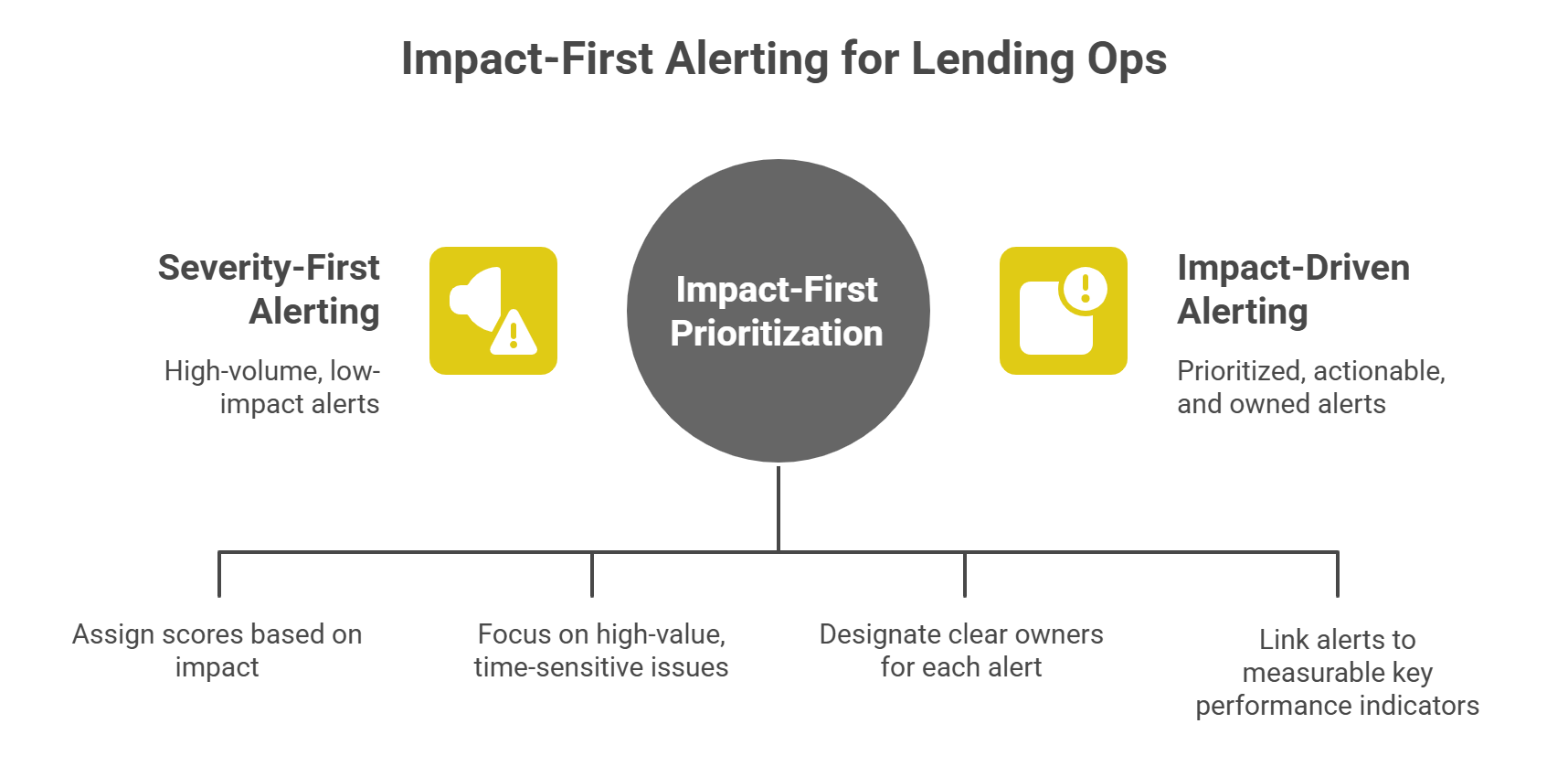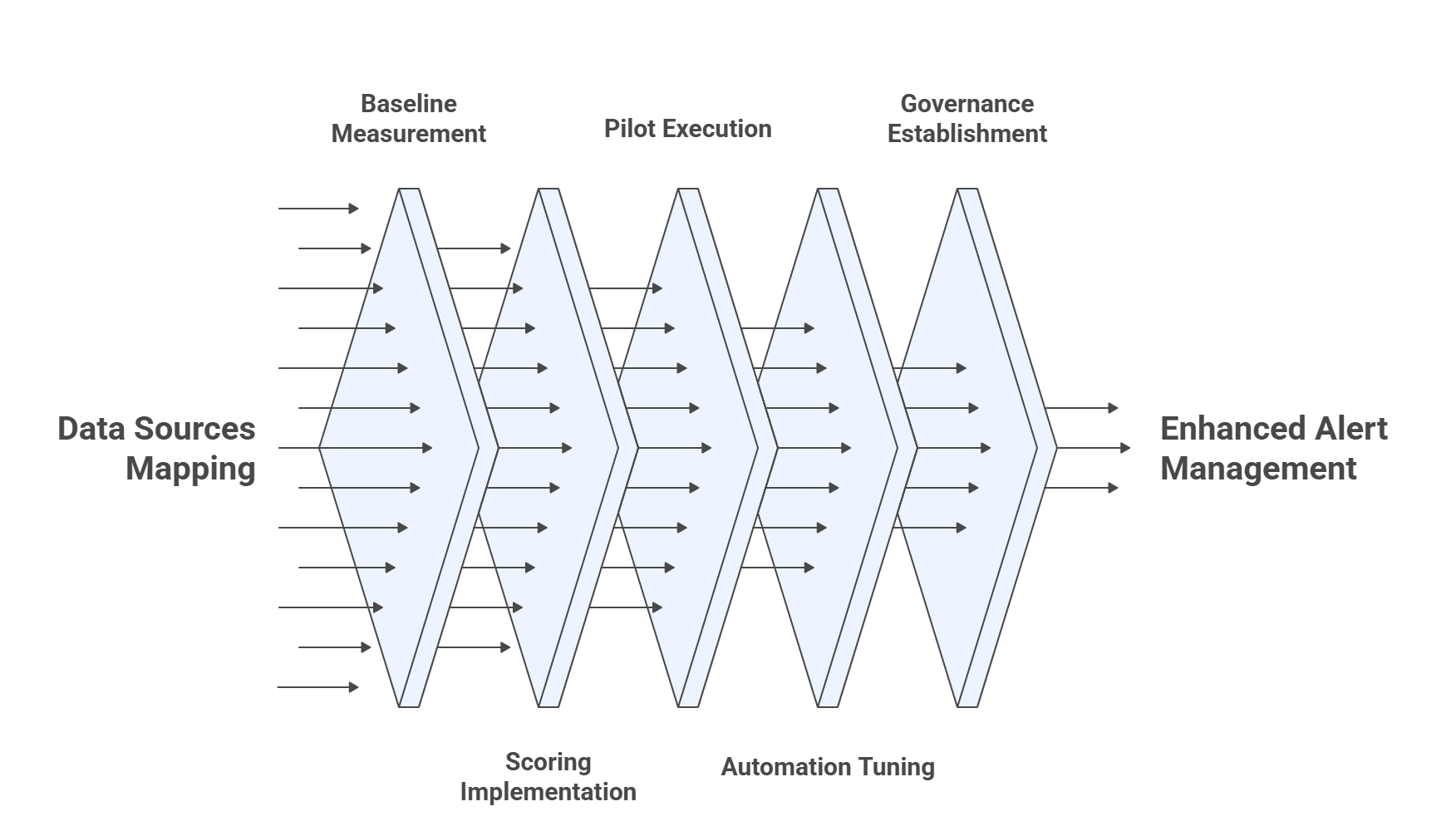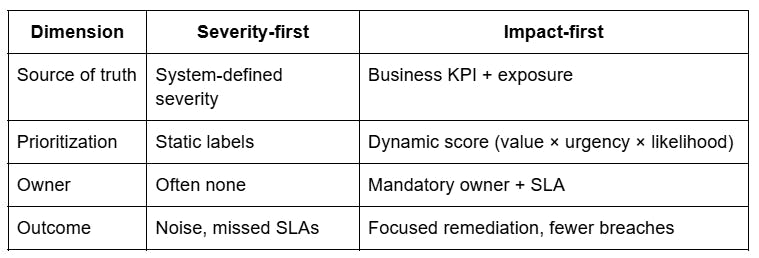Table of Contents
Loading table of contents...
Alert Fatigue in Lending Ops: Fixing the Wrong Things First
Stop wasting time on low-impact alerts! Learn how to streamline your operations and focus on what truly matters to prevent regulatory risks in lending.
August 25, 2025

AB

When everything is marked “critical,” teams waste hours fixing the wrong things first
Walk into any lending operations war room and you’ll see the same scene: dashboards glowing red, Slack channels buzzing with alerts, and ops teams frantically chasing down “critical” issues. Yet by the end of the day, the real problem, the one that actually risks SLA breaches or regulatory penalties remains unresolved.
This is alert fatigue. And in lending ops, it’s not just distracting, it’s expensive.
Why this problem matters now
Operations teams are drowning in signals. Security and ops studies show staggering alert volumes: enterprise SecOps receives thousands of alerts daily; academic studies of DevOps workflows show engineers overwhelmed by weekly alert counts where only a minority require direct action.
Meanwhile, data teams the backbone that converts signals into decisions - report that data quality and reliability are top priorities, and many teams are bogged down in “plumbing” rather than delivering impact. That means your alert stream is only as good as the data and wiring behind it.
Put simply: alert noise + brittle data + no business context = missed SLAs, regulatory risk, and burned teams.
What good and bad alerting looks like (real examples from lending ops)
Bad alerting (severity-first):
- LOS says: “Event: KYC retry failed - severity=critical.”
- Disbursement system says: “Mandate presentation failed - severity=critical.”
- Collections says: “Promised-payment missed - severity=critical.”
All land in the same channel. Ops scrambles, picks low-impact items, high-value SLAs slip.
Good alerting (impact-first):
- Alert #1: “High-value disbursement ₹5.2M - presentation failed; SLA breach possible in 3 hours - owner: Disbursements Lead.”
- Alert #2: “Mandate presentation spike (product X) - retry success rate down 25% vs baseline - investigate bank partner Y.”
- Alert #3: “KYC retry loop - affects 1.2% of incoming apps; projected lost conversions = 4,000/month - owner: Onboarding Ops.”
Each alert is scored, prioritized, owned, and tied to a measurable KPI.
Autonmis’ product materials and pilot approach are purpose-built to create these prioritized operational signals and accountable workflows across origination → disbursal → collections.

Checkout: How Predictive Analytics Improves Operational Efficiency
The core technical fix: an Alert Scoring Model (practical, implementable)
At the heart of impact-first alerting is a reproducible scoring function that converts system events into business-prioritized signals.
1) A concise scoring formula (start here)
Definitions & suggested weights (starter configuration)
- ValueAtRisk - monetary exposure of the alert (e.g., amount of disbursement, revenue at risk) - weight 0.4
- SLA_Urgency_Wt - time-to-SLA-breach factor (e.g., 0.0–1.0 where 1.0 = breach in <1 hour) - weight 0.25
- Likelihood_Wt - probability this event causes downstream failure (modelled from historical data) - weight 0.15
- Compliance_Wt * Compliance_Impact - regulatory sensitivity (e.g., KYC missing for regulated product) - weight 0.15
- Customer_Impact_Wt * Customer_Impact - number of customers or strategic customers impacted - weight 0.05
Use min-max normalisation on monetary figures and timestamps, cap the final AlertScore to 100, and set thresholds:
- 90–100: Immediate Exec/Ops attention (page owner + escalate)
- 70–89: Ops lead workqueue - resolve within SLA
- 40–69: Batch remediation or automated retry
- <40: Monitor / ingest into summary metrics
Why this works: it converts disparate system signals into a single, ranked, business-centric queue — so the team fixes the things that move KPIs and prevent SLA breaches first.
2) A sample SQL snippet to compute a retry-success signal (useful for mandate failures)
Use fail_rate to populate Likelihood_Wt and ValueAtRisk to compute AlertScore.
Implementation playbook - 6 practical phases (what I ran in production)
Phase 0 - Discovery (Week 0)
- Map data sources (LOS, disbursement logs, KYC provider, collections CRM). Autonmis’ pilots typically start here (days 0–2).
- Identify top 10 alert types that historically lead to SLA breaches.
Phase 1 - Baseline & Noise Audit (Week 1)
- Measure alert volumes, false positives, and time spent triaging per alert type.
- Compute precision@K for existing alerts where K=50 (how many top alerts are true positives).
Phase 2 - Scoring & Prioritization (Week 2–3)
- Implement the scoring function in the event pipeline (streaming or batch).
- Attach metadata: owner, SLA window, evidence links.
Phase 3 - Pilot (Week 4)
- Run 2-week live pilot on a slice of volume (e.g., disbursements or early collections). Autonmis’ pilots typically ship a leadership MIS pack + 6–10 high-signal alerts in this window.
- Track MTTR, SLA breaches, and ops hours.
Phase 4 - Iterate & Automate (Week 5–6)
- Automate retry flows for low-ValueAtRisk items; keep human-in-loop for high-score alerts.
- Tune thresholds and weights from observed precision/recall.
Phase 5 - Governance (Ongoing)
- Change history, runbook maintenance, audit trails, and scheduled MIS for leadership. Autonmis recommends role-based access and evidence trails for audit readiness.

Checkout: Why Dashboards Don’t Prevent SLA Breaches
Operational rules & playbook (what to enforce immediately)
- Every alert must have an owner - no owner = no action. Route to a person or role. (Automate routing with ownership tables.)
- Attach a resolution SLA to the alert - display countdown clock; escalate automatically when nearing breach.
- Group & deduplicate: if 100 events are the same failure (same bank partner + same failure signature), produce one aggregated alert with a list of representative events.
- Instrument alert quality: track AlertPrecision = ResolvedAsActionable / AlertIssued and AlertRecall = ActionableEventsDetected / TotalActionableEvents. Set targets (precision > 80% first, then improve recall).
- Audit & evidence: every resolved alert must leave a short trace (who, what, when, why, remediation steps) - required for regulatory audits.
Sample escalation matrix (example)
- Score ≥ 95 - Page Ops Lead + SMS to Head of Ops; 1-hour SLA.
- 90–94 - Notify Ops Lead + pop in command queue; 2-hour SLA.
- 70–89 - Routed to queue owner; 6-hour SLA.
- <70 - Batch-process / monitor.
KPIs to prove ROI (what to measure week over week)
- SLA Breach Count (weekly) - target: reduce by X% in pilot.
- MTTR for high-score alerts - median time.
- Ops hours spent on low-value alerts - measure reduction.
- Alert Precision & Recall - see above.
- Cost or revenue at risk recovered - monetise improvements where possible.
Autonmis pilots demonstrate measurable improvements when high-signal alerts and ownership models are deployed. Example deliverables include a Stuck Disbursement Command View, Mandate Presentation Tracker, and leadership MIS.
Common pitfalls and how to avoid them
- Pitfall: Over-complicating the scoring function.
Fix: Start with 3 signals (ValueAtRisk, SLA urgency, failure rate) and iterate. - Pitfall: Pushing more alerts to execs.
Fix: Execs should only see top-N high-impact incidents or a summary with drilldown. - Pitfall: Data-quality blind spots.
Fix: Invest 20% of pilot time in fixing mappings, identity resolution, and timestamp consistency (Autonmis onboarding highlights this phase). - Pitfall: No human ownership.
Fix: Make ownership non-negotiable, escalate unclaimed alerts automatically.
Quick comparison: Severity-first vs Impact-first

A compact, ready-to-use checklist (copy-paste into your runbooks)
- Inventory alert sources (LOS, KYC, disbursements, collections).
- Compute baseline alert volumes & triage time.
- Implement AlertScore with ValueAtRisk and SLA_Urgency. (Use SQL snippet above.)
- Route alerts to owners and set escalation rules.
- Run 14-day pilot, track MTTR & SLA breaches. Autonmis pilots typically deliver first dashboards and 6–10 high-signal alerts in this timeframe.
- Tune weights and expand to other pipelines.

Checkout: How to Improve Operational Efficiency in Fintech
Final note leadership & culture
Tools and models matter, but so does culture. The most successful recovery I led combined three things:
- A brutal audit of what alerts actually led to SLA breaches.
- A simple prioritization rule that everyone could read and defend (value × urgency).
- Relentless ownership - making one person accountable for each alert until it’s cleanly closed.
If you can turn alerts into accountable actions and measure whether alerts helped prevent SLA breaches, you’ll move from firefighting to confident operational control.
Recommended Blogs

10/17/2025

AB
How GFF 2025 Changes the Way BFSI Will Operate in India

10/13/2025

AB
Top 5 Ways to Improve Lending Operations for Business Growth
Actionable Operational Excellence
Autonmis helps modern teams own their entire operations and data workflow — fast, simple, and cost-effective.